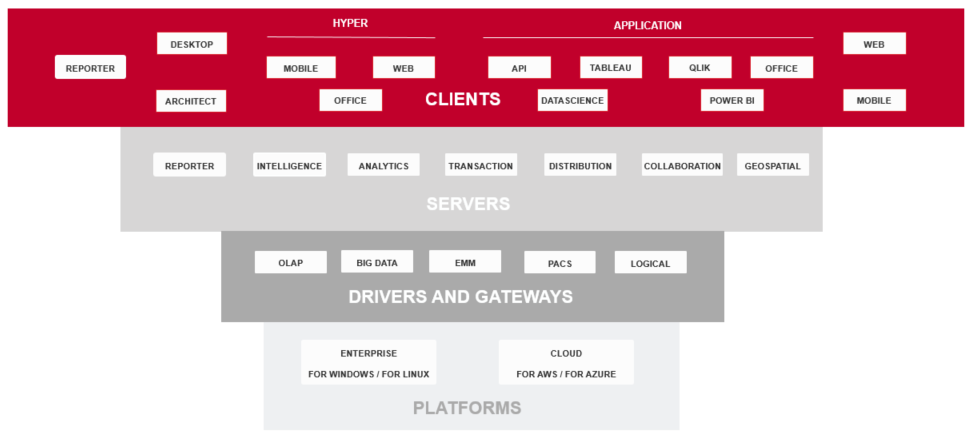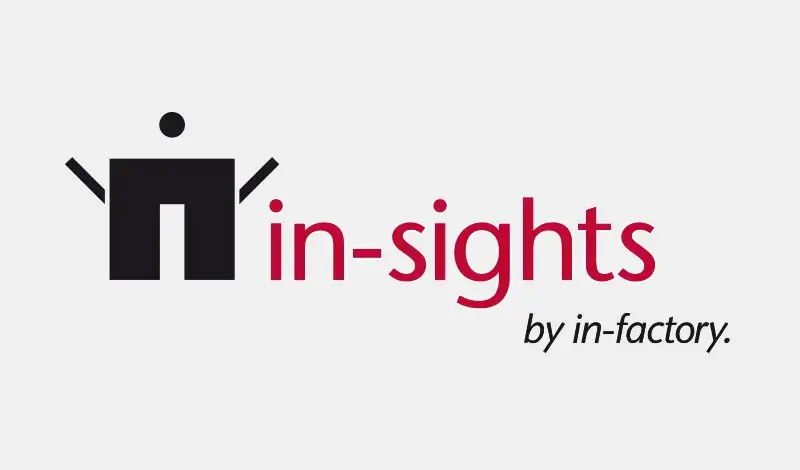With fresh input from MicroStrategy World 2022, our business intelligence experts introduce you to the elements of MicroStrategy 2020 in this blog article.
MicroStrategy 2020 Software Architecture
This software consists of 4 layers, which in turn consist of individual variable modules that can be combined according to the company's requirements.
The following diagram provides an overview of the layers and individual modules.

Microstrategy overview of the layers and the individual modules
Client reporter
This allows reports, documents and dossiers to be viewed. The views of the information can be personalized for users of the client.
Client Architect
Enables administrators and architects to create and manage the environment. A toolbox is available to these roles for this purpose. Parts of the toolbox:
The Integrity Manager tool is used to test and verify system integrity by automatically comparing SQL, data, reports and dossiers between environments.
The architect allows you to create a centralized data model and a project schema.
With the help of the Object Manager can be used to copy objects within a project or related projects.
With the tool Developer tool can be used to develop metrics, filters and other metadata objects as well as create reports, dossiers and more.
With the workstation it is possible to address the various usable platforms via just one interface. Both architectural (dossiers, reports, etc.) and administrative (users, applications, etc.) elements can be monitored and managed via this interface.
Client web
Is a browser-based tool. All existing roles (user, administrator, etc.) can use it to access all the designated analysis functions in MicroStrategy.
Client-Mobile
Collection of apps and services with which visualizations, analyses and more are possible. This makes it possible to use documents and dossiers on tablets and smartphones. Both iOS and Android are supported.
The following three client versions have one thing in common - HyperIntelligenceTM. There is a new object added to the workstation - cards. They can be created, managed and provided there. They can then be displayed in the following clients. When you move over a keyword, an information window is displayed on the screen/output device.
- Client-Hyper-Mobile is a mobile app that enables HyperIntelligenceTM on a mobile device.
- Client-Hyper-Web is a browser extension for HyperIntelligenceTM.
- Client Hyper Office enables HyperIntelligenceTM to be used in Microsoft Office applications.
Client application - Tableau / Qlick / Power BI
These are gateways that can be used to establish a connection to a MicroStrategy environment.U The application enables data located there to be extracted. This data can then be visualized and processed with the BI tool used. The gateways are intended for the BI toolsTableau, Qlick and Power BI.
Client-Application-DataScience
This application can be used to access the semantic layer of MicroStrategy to extract and upload data. These are the tools jupyter and RStudio, which are often used by data scientists (DataScientists).
Client-Application-Office
This application also enables a connection to the MicroStrategy environment. This is for users of Excel. In addition to the connection, it is also possible to search and import data from reports and data sets.
Server reporter
The counterpart for the Reporter Client. Supported by all platforms. Allows the user to view and interact with reports, documents, dossiers and cards.
Server intelligence
The foundation of the analytics platform. It provides centralized analytical processing and job management for reporting, analysis and monitoring applications with a powerful set of features required for a scalable, fault-tolerant, enterprise-wide business intelligence system.
In addition to the client reporter, all other available clients are supported. Applications and objects can be created, designed and saved, whether via the web or mobile. Simple maintenance and integrated security are also included.
Server transaction
Enables business users to submit transactions via customized forms for documents, dossiers or via interactive grids. The inclusion of surveys in dossiers for all platforms is available as an add-on for Intelligence.
Server distribution
This enables users to receive reports, dossiers and much more via a subscription. Configured by the administrator, users can subscribe themselves and others. Data monitoring and alerts can also be enabled. Distribution is a server add-on that is available in addition to Intelligence and is supported by all platforms.
Server collaboration
This is about collaboration and communication within individual dossiers. It is supported on all platforms, Library for Web and the mobile Library app and is intended as an add-on for Server Intelligence.
The drivers and gateways layer includes OLAP (Online Analytical Processing), Big Data and EMM (Enterprise Mobility Management). As these methods and techniques are used independently of BI applications, they are not covered here.
Enterprise platforms from Windows as well as Linux and cloud platforms from AWS (Amazon Web Services) and Azure (Microsoft) are supported.
Finally, two different product packages (bundles) that are put together/offered to meet specific consumer needs.
Consumer User
This product package includes the Client Reporter as well as the Server Reporter and Distribution. It is best suited for users who want to view and interact with MicroStrategy dossiers, reports and documents, as well as share the content created with others.
Power User
The second bundle consists of the client web and the servers Intelligence, Analytics and Distribution. This is suitable for users who want to create, design, analyze, share and store dossiers, reports and documents from MicroStrategy.
